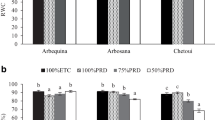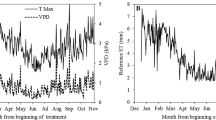Abstract
Olive (Olea europaea L.) is a drought-tolerant tree which is usually grown in areas with a Mediterranean climate that receive >350 mm of annual rainfall. However, olive growing in Syria has recently expanded into drier areas (200–300 mm annual rainfall) where irrigation resources are limited. This study, carried out between November 2002 and October 2005, aimed to investigate the response of a little known Syrian drought-tolerant olive variety (Qaisi) to water harvesting and limited summer irrigation (200 l per tree) in an arid area (average annual rainfall of 210 mm) with Mediterranean climate in Syria. Soil moisture and growth of four-year-old trees were monitored regularly. Olive leaves were sampled at different stages to determine water content, specific mass, and N content. Stomatal conductance was also measured in 2005. Our results showed that water harvesting and summer irrigation improved soil moisture content, leaf water content (up to 36% higher in Sep. 2003), leaf N content (up to 45% higher in Aug. 2003), leaf stomatal conductance (up to 55% higher in Apr. 2005), and relative trunk growth rate. Water harvesting was most successful in wet years, although the water storage capacity was not enough to retain all harvested water. This study indicated that it is possible to grow drought-tolerant olive varieties in arid areas under little or no irrigation, but proper water and nutrient management should be considered for sustainable growth.









Similar content being viewed by others
References
Abdeen, M., Tubeileh, A., Al-Ibrahem, A., & Turkelboom, F. (2005, April). Morphological characterization of nine Syrian olive (Olea europaea L.) cultivars. Paper Presented at the Conference: Promoting Community-Driven Conservation and Sustainable Use of Dryland Agrobiodiversity, Aleppo
Abd El-Rahman, A. A., & El-Sharkawi, H. M. (1974). Response of olive and almond orchards to partial irrigation under dry-farming practices in semi-arid regions: II. Plant–soil water relations in olive during the growing season. Plant and Soil, 41, 13–31. doi:10.1007/BF00017940.
Allen, R. G., Pereira, L. S., Raes, D., & Smith, M. (1998). Crop evapotranspiration. Guidelines for computing crop water requirements. FAO Irrigation and Drainage Paper 56, FAO, Rome.
Androulakis, I. I., Loupassaki, M. H., & Schwabe, W. W. (1997). The content of mineral elements in the leaves of the olive cv. Koroneiki in relation to irrigation and the time of sampling. Acta Horticulturae, 449, 119–124.
Belaj, A., Caballero, J. M., Barranco, D., Rallo, L., & Trujillo, I. (2003). Genetic characterization and identification of new accessions from Syria in an olive germplasm bank by means of RAPD markers. Euphytica, 134, 261–268. doi:10.1023/B:EUPH.0000004954.93250.f5.
Bouat, A. (1964, September-October). L’analyse foliaire et l’olivier. Paper Presented at the Colloque Européen sur le Contrôle de la Nutrition Minérale et de la Fertilisation, Montpellier.
Boujneh, D., Lemeur, R., & Ben El Hadj, S. (1998). Aspects anatomiques de la résistance à la sécheresse au niveau des feuilles d’oliviers (Olea europaea L.) de différentes provenances tunisiennes. Ezzaitouna, 4(1&2), 1–12.
Braham, M., & Lemeur, R. (1998). Etude de l’activité ecophysiologique de l’olivier (Olea europaea L.) soumis a une contrainte hydrique. Ezzaitouna, 4(1&2), 13–28.
Celano, G., Dichio, B., Mantanarro, G., Nuzzo, V., Palese, A. M., & Xiloyannis, C. (1999). Distribution of dry matter and amount of mineral elements in irrigated and non-irrigated olive trees. Acta Horticulturae, 474, 381–384.
Chartzoulakis, K., Patakas, A., & Bosabalidis, A. (1999). Changes in water relations, photosynthesis and leaf anatomy induced by intermittent drought in two olive cultivars. Environmental and Experimental Botany, 42, 113–120. doi:10.1016/S0098-8472(99)00024-6.
Critchley, W., & Siegert, K. (1991). Water harvesting. A manual for the design and construction of water harvesting schemes for plant production. Rome: FAO.
De Pauw, E., Ruysschaert, G., & Masri, Z. (2007). Soils. In A. Bruggeman, A. Rieser, J. Asfahani, B. Abou Zakhem & E. Luijendijk E (Eds.), Water resources and use in the Khanasser Valley, Syria. Aleppo: ICARDA.
Dimassi, K., Therios, I., & Passalis, A. (1999). Genotypic effect on leaf mineral levels of 17 olive cultivars grown in Greece. Acta Horticulturae, 474, 345–348.
Fernandez, J. E., & Moreno, F. (1999). Water use by the olive tree. Journal of Crop Production, 2, 101–162. doi:10.1300/J144v02n02_05.
Fernandez, J. E., Moreno, F., Girón, I. F., & Blazquez, O. M. (1997). Stomatal control of water use in olive tree leaves. Plant and Soil, 190, 179–192. doi:10.1023/A:1004293026973.
Fernandez-Escobar, R., Moreno, R., & Garcia-Creus, M. (1999). Seasonal changes of mineral nutrients in olive leaves during the alternate-bearing cycle. Scientia Horticulturae, 82, 25–45. doi:10.1016/S0304-4238(99)00045-X.
Ferreira-Llamas, J. (1984). Basis of fertilization in olive cultivation and the olive tree’s vegetative cycle and nutritional needs. In Anonymous (Ed.), International course on the fertilization and intensive cultivation of the Olive (pp. 1–25). UNDP/FAO/Spanish National Institute for Agricultural Research, Cordoba
Jones, J. B. (1985). Soil testing and plant analysis: Guides to fertilization of horticultural crops. Horticultural Reviews, 7, 1–68.
La Rovere, R., Aw-Hassan, A., Turkelboom, F., & Thomas, R. (2006). Targeting research for poverty reduction in marginal areas of rural Syria. Development and Change, 37, 627–648. doi:10.1111/j.0012-155X.2006.00493.x.
Lavee, S., Nashef, M., Wodner, M., & Harshemesh, H. (1990). The effect of complementary irrigation added to old olive trees (Olea europaea L.) cv. Souri on fruit characteristics, yield and oil production. Advances in Horticultural Science, 4, 135–138.
MAAR (Ministry of Agriculture and Agrarian Reform) Syria. (2007). The Annual Agricultural Statistical Abstract. Damascus: Department of Planning and Statistics, Division of Agricultural Statistics.
McCann, I., Bruggeman, A., Oweis, T., & Pala, M. (2008). Modification of the FAO-56 spreadsheet program for scheduling supplemental irrigation of winter crops in a Mediterranean climate. Applied Engineering in Agriculture, 24(2), 203–214.
Moriana, A., Villalobos, F. J., & Fereres, E. (2002). Stomatal and photosynthetic responses of olive (Olea europaea L.) leaves to water deficit. Plant, Cell & Environment, 25, 395–405. doi:10.1046/j.0016-8025.2001.00822.x.
Natali, S., Xiloyannis, C., & Angelini, P. (1985). Water consumptive use of olive trees (Olea europaea) and effect of water stress on leaf water potential and diffusive resistance. Acta Horticulturae, 171, 341–351.
Nseir, P., Nadaf, A., Boutros, M., & Khaddam, A. (1985). Choosing olive varieties adapted to arid zones. Damascus: ACSAD.
Pansiot, F. P., & Rebour, H. (1961). Improvement in Olive cultivation. Rome: FAO.
Reij, C., Mulder, P., & Begeman, L. (1988). Water harvesting for plant production. Washington: The World Bank.
Schiettecatte, W., Ouessar, M., Gabriels, D., Tanghe, S., Heirman, S., & Abdelli, F. (2005). Impact of water harvesting techniques on soil and water conservation: A case study on a micro catchment in southeastern Tunisia. Journal of Arid Environments, 61(2), 297–313. doi:10.1016/j.jaridenv.2004.09.022.
Schwabe, W. W., & Lionakis, S. M. (1996). Leaf attitude in olive in relation to drought resistance. Journal of Horticultural Science, 71(1), 157–166.
Spiegel, P. (1955). The water requirement of the olive tree, critical periods of moisture stress, and the effect of irrigation upon the oil content of its fruit. In H. Veenman (Ed.), XIV International Horticultural Congress, Wageningen SPSS Inc. (2004). Release 13.0.1 (pp. 1363–1373). Chicago: SPSS Inc.
Tubeileh, A., Abdeen, M., Al-Ibrahem, A., & Turkelboom, F. (2004a, September–October). Fruit and oil characteristics of three main Syrian olive cultivars grown under different climatic conditions. Paper Presented at the 5th International Olive Growing Symposium, Izmir.
Tubeileh, A., Bruggeman, A., & Turkelboom, F. (2004b). Growing olives and other tree species in marginal dry environments. Aleppo: ICARDA.
Xiloyannis, C., Celano, G., Palese, A. M., Dichio, B., & Nuzzo, V. (2002). Mineral nutrient uptake from the soil in irrigated olive trees, cultivar Coratina, over six years after planting. Acta Horticulturae, 586, 453–456.
Xiloyannis, C., Pezzarossa, B., Jorba, J., & Angelini, P. (1988). Effects of soil water content on gas exchange in olive trees. Advances in Horticultural Science, 2, 58–63.
Ziadat, F. M., Hattar, B. I., & Baqain, A. S. (2006). Farmers’ verification of improved land-use alternatives in the transitional Badia of Jordan. Renewable Agriculture and Food Systems, 21, 207–215. doi:10.1079/RAF2006155.
Acknowledgements
Thanks are due to Michael Zöbisch and Zuhair Masri for establishing the orchard. We would also like to acknowledge the technical help provided by Mohammad al-Ali and Ali Haj-Dibo and his staff. We are thankful to George Estefan and his staff for the analyses of soil and plant material. The cooperation of Faraj al-Issa, the farmer who allowed us to work on his land, was much appreciated. We would also like to express our gratitude to the German Federal Ministry for Economic Cooperation and Development (BMZ) for partially funding this work through KVIRS project.
Author information
Authors and Affiliations
Corresponding author
Additional information
Readers should send their comments on this paper to: BhaskarNath@aol.com within 3 months of publication of this issue.
Rights and permissions
About this article
Cite this article
Tubeileh, A., Bruggeman, A. & Turkelboom, F. Effect of water harvesting on growth of young olive trees in degraded Syrian dryland. Environ Dev Sustain 11, 1073–1090 (2009). https://doi.org/10.1007/s10668-008-9167-y
Received:
Accepted:
Published:
Issue Date:
DOI: https://doi.org/10.1007/s10668-008-9167-y




